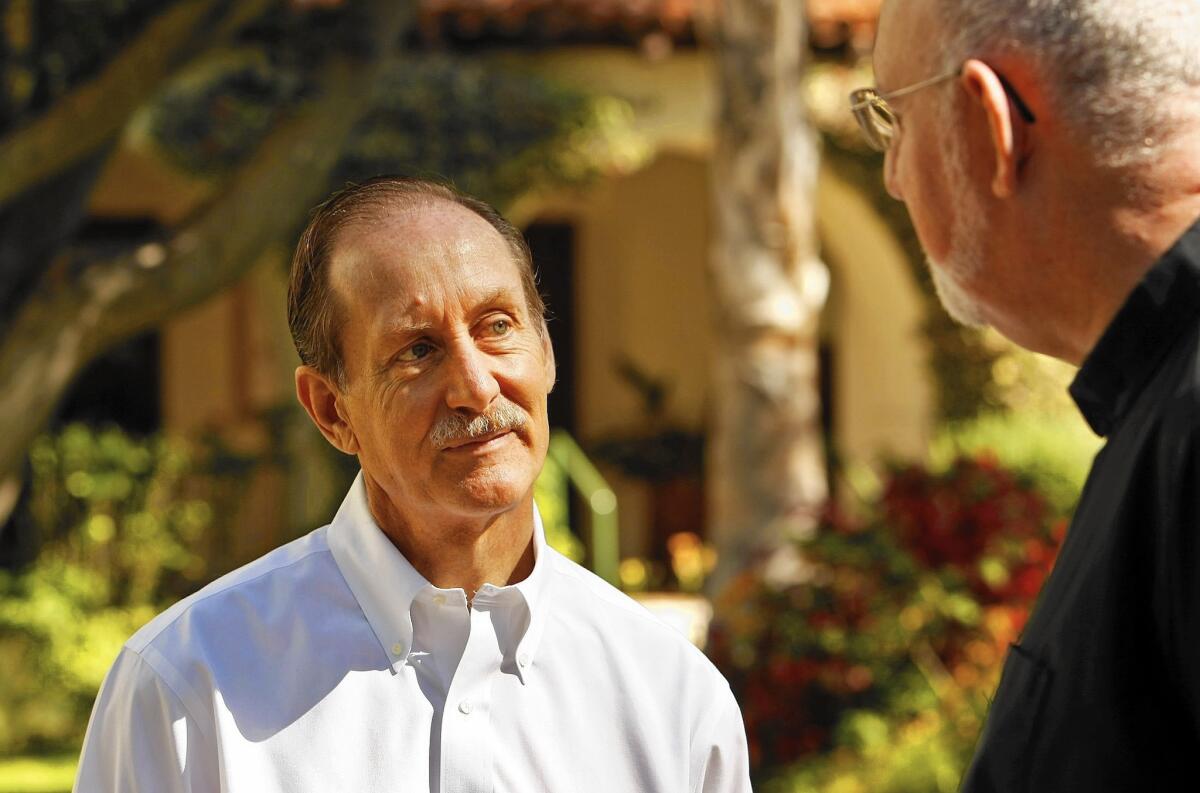Critic’s Notebook: Visionaries search for key to civic engagement in L.A.

The 3-year-old house owned by Jeanne and Anthony Pritzker, high on Angelo Drive in the upper reaches of Beverly Hills, is a vast and imposing neo-modern chateau, loosely Richard Meieresque in feel, that holds a notable collection of contemporary art and covers 49,000 square feet. It opens onto a lawn as long as a fairway and offers a view stretching from the downtown skyline to the ocean.
It was in the sunken living room of that house that Donna Bojarsky, former aide to Tom Bradley and archetypal “connector” in the Tipping Point mold, convened a high-minded discussion Tuesday evening on what she considers the pitiful state of civic engagement in Los Angeles.
The guests, perhaps 150 in all, included Michael Govan, director of the L.A. County Museum of Art; California Endowment President Bob Ross; the musician Moby, who is an L.A. architecture buff; Madeleine Brand of KCRW-FM (89.9); and David Ryu, newly elected member of the L.A. City Council. They were nearly outnumbered by a phalanx of waiters, bartenders, valet-parking attendants and security guards.
One woman appeared to have the job of standing for the entire night next to a transparent, low-slung blue artwork in the style of DeWain Valentine and politely informing those looking for a place to sit that it was not, in fact, a bench.
Bojarsky began by saying that while exciting “change is afoot” in Los Angeles, new strategies to marshal that change were required if the city had any hope of reaching “world-class” status. As a result, she has started a group called Future of Cities: Leading in L.A., which will hold its public debut at an event in October at LACMA.
I could swear there were a few groans, barely audible, when Bojarsky admitted some nostalgia for the efficiency and effectiveness of the Committee of 25, which controlled L.A. in the post-war years — nostalgia that should be tempered, she was quick to add, by how white that group was. She then introduced speakers including Govan, Ross, L.A. magazine editor Mary Melton and historian William Deverell, director of the Huntington-USC Institute on California and the West.
Deverell offered a useful long-view perspective on cycles of change in Southern California. Gregory Rodriguez, a founder of the Zocalo Public Square series, was eager to throw cold water on the notion that any meaningful change was underway. He was especially keen to share his thoughts on bike lanes, and how we are unwise to think they will do anything but turn L.A. into a “great Danish village.” No bike lanes are planned for Angelo Drive, as far as I know.
Bojarsky is right, of course, that L.A.’s civic fabric has long been flimsy and prone to fray; for many decades, the city has been far better at promoting, and enabling, individual than collective ambition.
Yet the precise outlines of her fledgling group’s agenda remained fuzzy. As the program wore on, the crowd in the living room thinned. When Bojarsky called out for Moby, the answer came back from a far corner that he had left already, to deal with a balky mixer, presumably somewhere down the hill and far from the 90210
Left unexplored was the success or failure of other notable recent attempts, by the Broad Foundation and others, to groom a new generation of leaders. Similarly unclear was the extent to which the discussion was meant as a critique of Eric Garcetti and his still-young administration.
Bojarsky, who supported Garcetti’s opponent Wendy Greuel, another former Bradley aide, said some complimentary things about the mayor during her introduction, and a few City Hall figures were in attendance, including Garcetti’s young chief data officer, Abhi Nemani. But it was outgoing L.A. Deputy Mayor Rick Cole, soon to take over as Santa Monica’s city manager, whose presence struck the most intriguing note of all.
A popular parlor game among city-watchers has been to divine the true reasons for Cole’s move. Should we see his departure as a sign that it’s time to lower our expectations for the Garcetti administration and the future of our great Danish village? After failing to collar him at the Pritzker house, I tracked him down by email.
“I’m leaving because I got a cool job in a cool city that has money,” he wrote back. “I wish I could stay to keep my shoulder to a very, very big wheel. But I’m going where the wheel is smaller and it is already greased.”
He added, rather ominously, “L.A. is not designed to work.” Italics his.
christopher.hawthorne@latimes.com
More to Read
The biggest entertainment stories
Get our big stories about Hollywood, film, television, music, arts, culture and more right in your inbox as soon as they publish.
You may occasionally receive promotional content from the Los Angeles Times.







